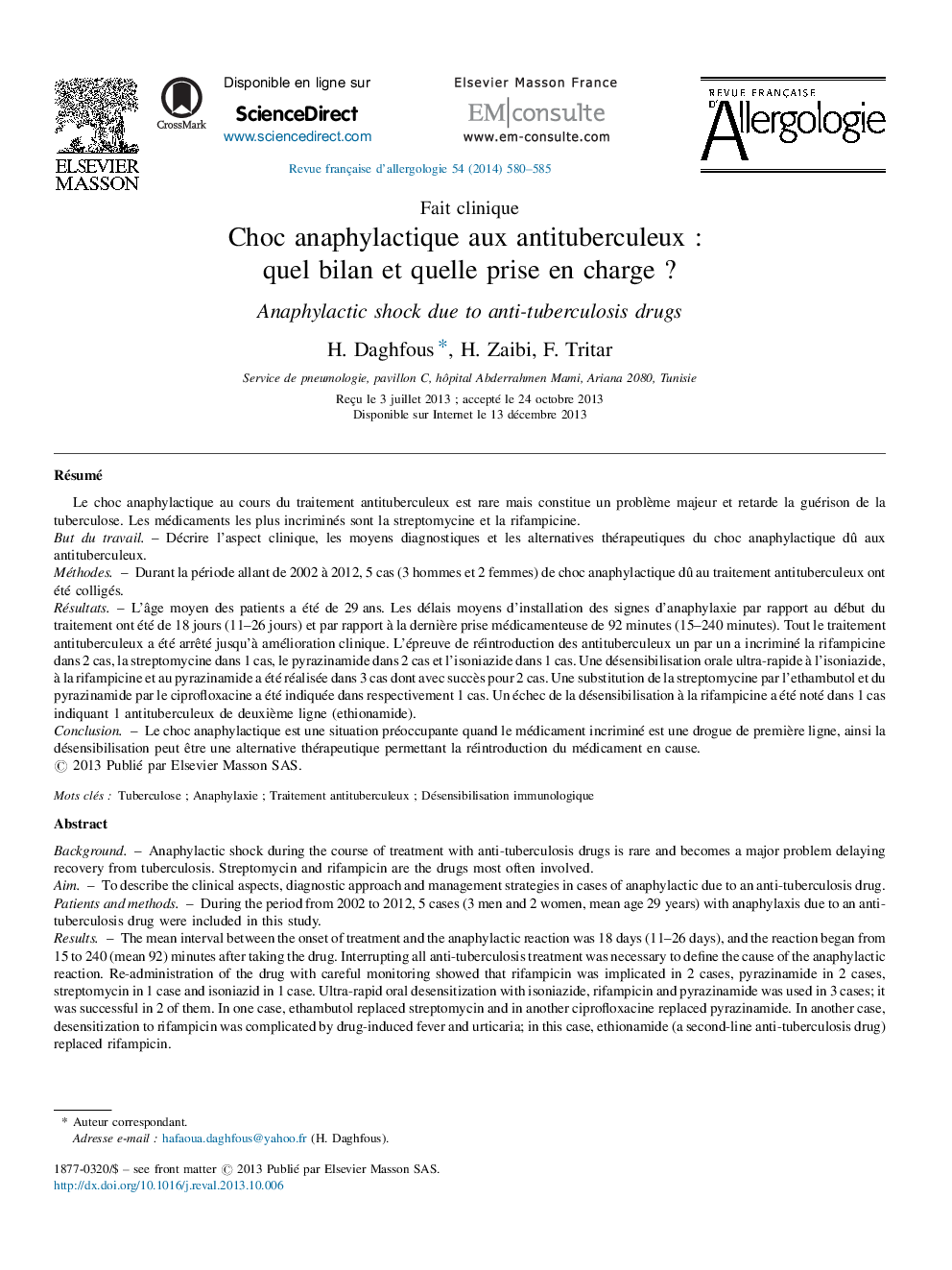| کد مقاله | کد نشریه | سال انتشار | مقاله انگلیسی | نسخه تمام متن |
|---|---|---|---|---|
| 3386040 | 1220635 | 2014 | 6 صفحه PDF | دانلود رایگان |

RésuméLe choc anaphylactique au cours du traitement antituberculeux est rare mais constitue un problème majeur et retarde la guérison de la tuberculose. Les médicaments les plus incriminés sont la streptomycine et la rifampicine.But du travailDécrire l’aspect clinique, les moyens diagnostiques et les alternatives thérapeutiques du choc anaphylactique dû aux antituberculeux.MéthodesDurant la période allant de 2002 à 2012, 5 cas (3 hommes et 2 femmes) de choc anaphylactique dû au traitement antituberculeux ont été colligés.RésultatsL’âge moyen des patients a été de 29 ans. Les délais moyens d’installation des signes d’anaphylaxie par rapport au début du traitement ont été de 18 jours (11–26 jours) et par rapport à la dernière prise médicamenteuse de 92 minutes (15–240 minutes). Tout le traitement antituberculeux a été arrêté jusqu’à amélioration clinique. L’épreuve de réintroduction des antituberculeux un par un a incriminé la rifampicine dans 2 cas, la streptomycine dans 1 cas, le pyrazinamide dans 2 cas et l’isoniazide dans 1 cas. Une désensibilisation orale ultra-rapide à l’isoniazide, à la rifampicine et au pyrazinamide a été réalisée dans 3 cas dont avec succès pour 2 cas. Une substitution de la streptomycine par l’ethambutol et du pyrazinamide par le ciprofloxacine a été indiquée dans respectivement 1 cas. Un échec de la désensibilisation à la rifampicine a été noté dans 1 cas indiquant 1 antituberculeux de deuxième ligne (ethionamide).ConclusionLe choc anaphylactique est une situation préoccupante quand le médicament incriminé est une drogue de première ligne, ainsi la désensibilisation peut être une alternative thérapeutique permettant la réintroduction du médicament en cause.
BackgroundAnaphylactic shock during the course of treatment with anti-tuberculosis drugs is rare and becomes a major problem delaying recovery from tuberculosis. Streptomycin and rifampicin are the drugs most often involved.AimTo describe the clinical aspects, diagnostic approach and management strategies in cases of anaphylactic due to an anti-tuberculosis drug.Patients and methodsDuring the period from 2002 to 2012, 5 cases (3 men and 2 women, mean age 29 years) with anaphylaxis due to an anti-tuberculosis drug were included in this study.ResultsThe mean interval between the onset of treatment and the anaphylactic reaction was 18 days (11–26 days), and the reaction began from 15 to 240 (mean 92) minutes after taking the drug. Interrupting all anti-tuberculosis treatment was necessary to define the cause of the anaphylactic reaction. Re-administration of the drug with careful monitoring showed that rifampicin was implicated in 2 cases, pyrazinamide in 2 cases, streptomycin in 1 case and isoniazid in 1 case. Ultra-rapid oral desensitization with isoniazide, rifampicin and pyrazinamide was used in 3 cases; it was successful in 2 of them. In one case, ethambutol replaced streptomycin and in another ciprofloxacine replaced pyrazinamide. In another case, desensitization to rifampicin was complicated by drug-induced fever and urticaria; in this case, ethionamide (a second-line anti-tuberculosis drug) replaced rifampicin.ConclusionAnaphylactic shock is a preoccupying situation when the drug in question is a first-line drug, in which case oral desensitization can be a therapeutic alternative allowing re-introduction of the responsible drug.
Journal: Revue Française d'Allergologie - Volume 54, Issue 8, December 2014, Pages 580–585